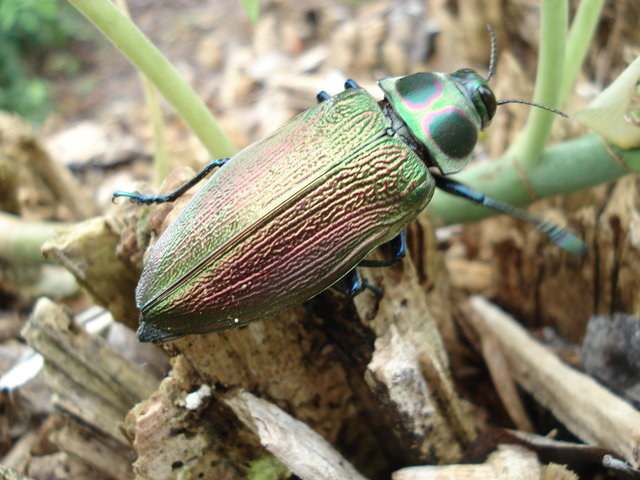Euchroma gigantea is a beetle belonging to the Burpestidae family, which is integrated of approximately fifteen thousand species. E. gigantea is the largest of all and the only species of its genus, divided into 5 subspecies. It is distributed from Mexico to Argentina and also Cuba (Martínez, 2018).
Description
Its body is robust, elongated and somewhat flattened. Its entire exoskeleton is metallic in color, with a mixture of green, bronze and purple, although in the pronotum it has two large, diffuse blackish spots, one on each side and separated from each other, which occupy most of its surface. The head and pronotum are quite smooth, whereas the elytra have an intricately rough sculpture. The newly emerged specimens have the elytra covered with a yellow mealy tomentum, but this coverage is quickly lost with wear and tear against branches and leaves. The mature larvae can be up to six inches in length and are creamy yellow in color (Martínez, 2018).
Euchroma gigantea
Bernal, D. (2015)
E. gigantea inhabits the jungles of warm lands at low altitude, from sea level to 2200 meters above sea level. It is of daytime activity and is usually found on the trunks of trees. They reproduce between December and March. The males attract the females through the sound they produce with their elytra. Fertilized females lay up to 240 eggs per season, they are brown in color and take about 3 weeks to hatch. Its larvae produce galleries inside felled logs, feeding on dead wood, with a strong preference for Bombacaea wood (Bombacopsis, Ceiba, Ochroma, Pachira, Pseudobombax), but it has also been recorded on Ficus wood and even from Araucaria. They spend eight months in the larval phase, feeding first under the bark of the trunk and then moving to the roots (Martínez, 2018). In Mexico, the consumption of larvae by different ethnic groups from different localities has been recorded (Ramos & Pino, 2004).
PDF, Articles, Books on Euchroma gigantea
- 1998
- Diagnóstico nacional de plagas y enfermedades forestales en Costa Rica. Instituto Tecnológico de Costa Rica. Centro de Investigación en Integración Bosque Industria. 2 Pages.
Available Online:
www.cerambycoidea.com/titles/arguedas1998.pdf
- 2006
- Clasificación de tipos de daños producidos por insectos forestales. Segunda parte. Kurú: Revista Forestal (Costa Rica). Vol. 3, No. 9. 8 pages.
Available Online:
https://dialnet.unirioja.es/descarga/articulo/5123221.pdf
- 2008
- High Levels of Chromosomal Differentiation in Euchroma gigantean L. 1735 (Coleoptera, Buprestidae). Genetics and Molecular Biology, Vol. 31. Pages
Available Online:
www.scielo.br/pdf/gmb/v31n2/a07v31n2.pdf
- 1998
- Aspectos sobre la biología de Euchroma gigantea (L., 1758) (Coleoptera-Buprestidae) EM Pachira aquatica AUBLET (Bombacaceae). Escola de Agronomía da Universidad Federal de Goiás. 5 pages.
Available Online:
www.revistas.ufg.br/pat/article/view/2984/3030
- 1993
- Latin American Insects and Entomology. University of California Press. 536 pages.
Available Online:
www.amazon.com/Latin-American-Insects-Entomology-Charles/dp/0520078497
Comment: information about E. gigantea on page 275.
- 2008
- Guía de Artrópodos de Arcediano. Comunicación Institucional CEA Jalisco. Comisión Estatal del Agua. Gobierno de Jalisco. Pages 118- 119.
Available Online:
www.researchgate.net/profile/Emmanuel_Arriaga-Varela/publication/
272171614_Guia_de_Artropodos_de_Arcediano/links/
54dd9e630cf28a3d93f9d121.pdf?origin=publication_detail
- 1910
- The Spermatogenesis of Euchroma gigantea. University of Chicago Press.
Available Online:
www.journals.uchicago.edu/doi/pdfplus/10.2307/1535962
- 2008
- Environmental Impact Assessment. The proposed mount edgecombe cemetery, mount edgecombe / Belmont, Westmoreland. 127 pages.
Available Online:
http://nepa.gov.jm/new/services_products/applications/eias/docs/Westmoreland
/mount_edgecombe/eia-belmont7oct2008.pdf
Comment: information about E. gigantean on page VII and 35.
- 2015
- Temolines. Los Colepteros entre los Antiguos Mexicanos. Universidad Nacional Autónoma de México. Ciudad Universitaria, Delegación Coyoacán. Instituto de Biología. 226 pages
Available Online:
www.ibiologia.unam.mx/barra/publicaciones/Temolines.pdf
Comment: information of E. gigantean on page 40-41.
Suggested web pages with photos and information on Euchroma gigantea
www.arkive.org/giant-metallic-ceiba-borer/euchroma-gigantea/
Photos and information.
www.biodiversidadvirtual.org/insectarium/Euchroma-gigantea-Linnaeus-1758-img261710.html
Photos.
http://www.blog.illustraciencia.info/2017/04/euchroma-gigantea-linnaeus-1758-marco.html
Illustration of E. gigantea
http://carnivoraforum.com/topic/9690836/1/
Photos.
http://animaldiversity.org/accounts/Euchroma_giganteum/
Information.
www.naturepl.com/search?s=Euchroma+Gigantea
Photos.
www.backyardnature.net/yucatan/euchroma.htm
Photos and information.
First posted, December 2017.
Bibliography prepared by Marcella Sarti, FLAAR Mesoamerica.
























